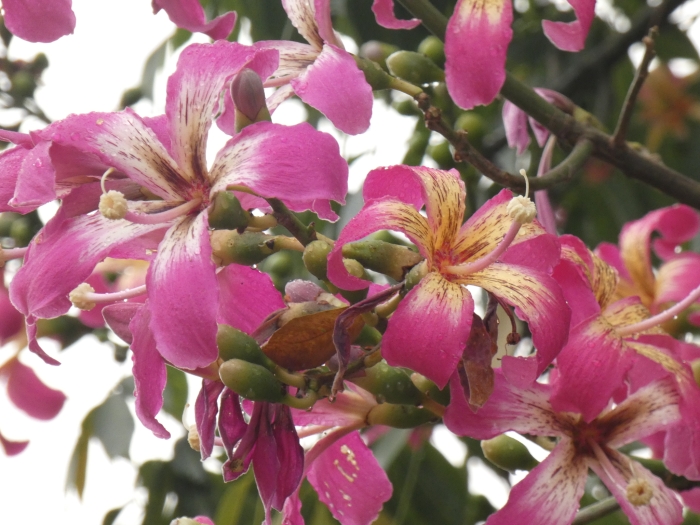Floss Silk Tree
(Ceiba speciosa)
Floss Silk Tree (Ceiba speciosa)
/
/

© María Zeta
CC BY 4.0
Image By:
© María Zeta
Recorded By:
Copyright:
CC BY 4.0
Copyright Notice:
Photo by: © María Zeta | License Type: CC BY 4.0 | License URL: http://creativecommons.org/licenses/by/4.0/ | Uploader: mariazeta | Publisher: iNaturalist |





































































Estimated Native Range
Summary
Ceiba speciosa, commonly known as the Floss Silk Tree, is a deciduous tree native to the tropical and subtropical dry forests of South America, particularly in Brazil, Argentina, and Paraguay. It exhibits a fast growth rate in spurts, especially when water is abundant, and can reach heights exceeding 25 meters (82 ft). The tree is notable for its distinctive bottle-shaped trunk, which bulges in the lower third and can measure up to 2 meters (7 ft) in girth. The trunk and branches are studded with thick, sharp conical prickles, which serve as a defense mechanism against climbing animals. Young trees have a green trunk due to high chlorophyll content, allowing photosynthesis when leaves are absent, but the trunk turns gray as the tree ages. The horizontal branches also bear prickles. Ceiba speciosa boasts large, showy flowers with creamy-whitish centers and pink tips on their five petals, each measuring 10 to 15 centimeters (4 to 6 in) in diameter, resembling hibiscus flowers. The flowering season is from February to May in its native range, but it can bloom at other times elsewhere.
The Floss Silk Tree is cultivated for its ornamental value, showcasing its stunning flowers and unique trunk form. It is used in urban street planting, despite requiring safety buffer zones due to its prickles. This species thrives in full sun and requires medium amounts of water and well-drained soils. It is relatively easy to maintain but should be monitored for pests such as the Giant Whitefly. While it is not typically invasive, its size and prickles can be problematic if not managed properly in urban settings.CC BY-SA 4.0
The Floss Silk Tree is cultivated for its ornamental value, showcasing its stunning flowers and unique trunk form. It is used in urban street planting, despite requiring safety buffer zones due to its prickles. This species thrives in full sun and requires medium amounts of water and well-drained soils. It is relatively easy to maintain but should be monitored for pests such as the Giant Whitefly. While it is not typically invasive, its size and prickles can be problematic if not managed properly in urban settings.CC BY-SA 4.0
Plant Description
- Plant Type: Tree
- Height: 30-60 feet
- Width: 20-30 feet
- Growth Rate: Moderate
- Flower Color: Pink
- Flowering Season: Summer, Fall
- Leaf Retention: Deciduous
Growth Requirements
- Sun: Full Sun
- Water: Medium
- Drainage: Fast
Common Uses
Butterfly Garden, Fragrant, Low Maintenance, Showy Flowers
Natural Habitat
Tropical and subtropical dry forests of South America, particularly in Brazil, Argentina, and Paraguay
Other Names
Common Names: Silk Floss Tree, Palo Borracho, Toborochi, Paineira, Ceiba Orquidea, Flor De Mayo
Scientific Names: , Chorisia speciosa, Ceiba speciosa, Chorisa speciosa, Spirotheca rimbachii, Chorisia speciosa var. paraguariensis, Chorisia speciosa var. minor,
GBIF Accepted Name: Ceiba speciosa (A.St.-Hil., A.Juss. & Cambess.) Ravenna